Home » 2014
Yearly Archives: 2014
MyCourseRoom as your new year’s resolution
With the new year fast approaching, most of us think about our new year’s resolution(s). We all know the old stand-bys:
- Lose Weight
- Get a Better Job
- Save Money
- Get Fit
- Eat Healthy Food
- Manage Stress
Why not make MyCourseRoom.com part of your new year’s resolution. With our catalog of soft and hard skill courses that are PMI, CPHQ and CPE/CEU certified, we can help you grow and learn. Courses such as: Stress Management, Self-Esteem and Self-Confidence, and Time Management can assist with personal growth. While courses such as: Understanding Organizational Behavior, Performance Review, Scope Management and Quality Management focus on professional growth.
Below is a wonderful testimonial about MyCourseRoom.com and our courses.
Hope you are doing well! This is actually to inform you I have completed the MyCourseRoom training program and it’s one of the best things I have gone through and learned at my company. I completed the following courses:
Conflict Management: The best thing I learned in this was to look at the facts rather than going with the emotions and listening to the other person and putting yourself in his/her shoes and then making an informed decision which comes down to one principle i.e. Respect.
Giving and Receiving Feedback: Here I got to know the importance of giving honest and timely feedback and always welcoming feedback with an aim to improve on a regular basis.
Time Management: This was the best one I would say. Prioritizing your work and applying different rules like 80/20 and Murphy’s law one gets to complete tasks on time and eventually feel rewarded about it.
Communication: Here I learned what medium to use and when (Email, telephone or voicemail) along with the importance of body language in effective communication.
Team Building: Now this was something that I felt good about as I went through many things that I was practicing myself such as assigning different duties to seniors and creating a bonding through effective seat adjustments and keeping them focused towards one goal.
Last but not the least I would like to thank you and my company for providing me the opportunity to see and observe myself and things around me in a larger perspective so that I could overcome my flaws, see my strengths, focus on my present, plan for the future and grow myself and emerge as a true leader with all its traits eventually prove to be beneficial for the company’s and my success.
All of our courses are free to take, and the only cost to you is if you choose to print credentialed certificates ($10 per year), get transcripts ($15 per year) or take any of the paid assessments ($35 per year). If you decide that you would like access to all three of these options, it is $40 for a full 365 days (a $20 savings).
How does empowerment help you?
All too often “delegation” and “empowerment” are used interchangeably. Delegation is not empowerment. Delegation is when someone assigns a task to another person and then checks to see if the task is done. Empowerment is about giving an individual the authority to make decisions and be able to follow through once a decision is made. For example, customer service representatives may be empowered to offer a credit to satisfy an angry customer. In many cases, delegation and empowerment overlap, but they are not interchangeable.
“It is important to phase the process of empowerment, giving increasing decision-making authority to people as their capacity, skills, and knowledge increases.” – Empowerment and Accountability, MyCourseRoom.com
Empowerment is a process and like any process will take time to develop. However, such processes have tremendous benefits for the individual, the manager, and the organization.
Some of these benefits include:
- Improved quality: If someone has the authority to make a decision, they tend to put more effort and more interest into the quality of what they are doing.
- Better decisions: People doing the job know more about that job than anyone else.
- Increased efficiency: Requests or questions are dealt with faster because there is little to no red tape.
- Improved motivation and commitment to getting things done: The more say you have in something the more that you care. For example, if a student can select the subject of a book report, they will be more motivated to get the job done.
- Improved self-confidence and development: If people feel that they have stock in something, they are more interested in the outcome which will boost their confidence.
By empowering those that you manage and/or teach, you are allowing them to become part of the process and own what they are doing. This will in turn give a higher degree of satisfaction and quality. To learn more, take the free Empowerment and Accountability course at MyCourseRoom.com.
Performance Reviews
“Performance Reviews are opportunities to refuel, re-energize, and rejuvenate. If you do this regularly, you will achieve your goals.” – Performance Review, MyCourseRoom.com
Whether you are an owner of a child care center, an educator, a student, or a manager in a fortune 500 company, performance reviews are an important and effective way to evaluate, identify and plan personal and professional development. Whether you are being reviewed or are the reviewer, these appraisals often cause anxiety. However, if done correctly a vast amount of knowledge and growth can result.
Similar to shoes, there is not a ‘one size fits all’ method when it comes to performance appraisal. There are numerous methods that are used and in both the formal and informal setting. It is up to the reviewer to find the best appraisal method. This involves looking at the various factors that are in play. Factors in determining the best method to use include:
· Number of employees
· Organizational philosophy
· Understanding level of employees
· Knowledge level of manager
· Time constraints
Below are four methods of performance appraisal. Each of these requires different levels of involvement:
· Graphic Ratings
The Graphic Ratings method is one of the most widely used methods. It is also one of the easiest to use and understand. Using either a numerical scale (1-5) or judgments (such as ‘poor,’ ‘average,’ ‘good,’ ‘very good’ and ‘superior’), the reviewer grades various aspects of the individual’s performance. While this method is easy to use and comprehensive, there is a possible major drawback. If you do not clearly define what each “grade” is, there is a limited chance of effectiveness.
· Rankings
The Rankings method involves ranking everyone in a section according to performance and/or value to the organization or team. These rankings are often reclassified into the ‘top one-fifth’ or ‘top 10%.’ This method is commonly used in larger organizations, sales-related positions, and also in education (top 10% of the graduating class, etc.). The advantage of this method is that all individuals are rated against each other, and it provides them with a benchmark that is obtainable. It also identifies individuals that have done an exemplary job and a model that others can strive to emulate.
· Critical Incidents
In comparison to the prior two methods, the Critical Incidents method requires the most amount of time and dedication on the part of the reviewer. This method involves recording behavior over a pre-determined period of time (e.g. 1 month, 6 weeks, etc.). The reviewer keeps a diary of examples of effective and ineffective performance and then provides this information to the person during the review. At this time, the reviewer would also provide recommendations for how to change or fix ineffective performance.
· BARS (Behavioral Anchoring Rating Scale)
In this method, the reviewer rates a person on specific behaviors derived from specific performance dimensions. Everyone that is being reviewed is evaluated using the same rating scale for the same tasks. While one of the greatest advantages of this method is that all individuals are evaluated using the same criteria, one of the greatest disadvantages is that each behavior must be prioritized when making any sense of the review.
As you can see, there are numerous methods for performance review. How you review people is based on your needs and restraints. To learn more about performance appraisal, take the free Performance Review course from MyCourseRoom.com. Simply log in or sign up for your free learner account, and you can either add the course to your Q or start immediately.
Save your meeting with M.E.E.T.
Whether you are conducting a meeting at work or for a community event, the key to the success of that meeting is how well it is organized and facilitated. Most of us have attended meetings where we felt that nothing had been accomplished. Setting clear objectives and communicating those objectives to the meeting participants is essential.
“Define your business goals clearly so that others can see them as you do.” – George F. Burns
Pin the tail on the donkey is a rather difficult game because you are disoriented and can’t see the target. Running a meeting without meeting objectives is very similar. You know that the meeting must accomplish something, but you do not have a clear idea what topics need to be discussed or in what order. The next time that you are setting meeting objectives remember the acronym M.E.E.T. Successful objectives are: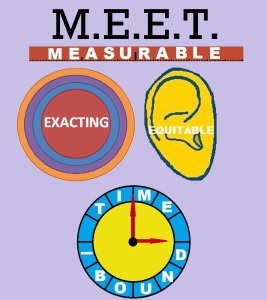
- Measurable: Just like any objective or goal, it is only effective if you know when it has been completed. When you discuss an objective during the meeting, make sure that the team members know what the desired outcome is and when it has been reached.
- Exacting:When you state an objective, use concrete and specific terms rather than vague, general and opinion-based concepts/words.
- Equitable:It is somewhat pointless to hold a meeting if the people involved do not understand the reason they are there. Very little will be accomplished. It is your job to verify that everyone at the meeting understands the project and the reason for the meeting. You should verify that all parties felt that they are heard. The team should achieve consensus, and the resulting decisions should be agreed to in writing.
- Time-bound: It is necessary to identify and agree to a reasonable time allocation, and it must be likely that the objectives of the meeting will be achieved within the given timeframe. Keep the meeting objectives practical.
If a problem cannot be solved within the meeting, create a splinter target group that will quickly meet and report back with a solution. If the timeframe of an objective is left open-ended without a definite path for resolution, the work required may never be completed! Perfectionists and lazy people alike have a hard time working without deadlines.
By setting the meeting objectives you are giving clear, verifiable tasks to be discussed and implemented. This will allow you to have a productive meeting. Do not have a meeting simply for the sake of having a meeting. Meetings should focus on things such as planning for action or making decisions. Having a meeting is not a goal in itself nor should your meeting be with the sole objective to educate people. To learn more about the effective facilitation of meetings, take the free course “Effective Facilitation of Meetings” at MyCourseRoom.com.
Make the most of your meetings
Whether it is organizing a community event or planning for the successful execution of a company project, you will need to arrange for a meeting where the people concerned can discuss how to go about the task at hand. The Effective Facilitation of Meetings course at www.mycourseroom.com will help you understand the intricacies of holding a successful meeting. Below is a quick overview of how an effective meeting is run.
Find the key people – The first step is to list the key people who will be executing the project and inform them of the place and time of the meeting. Provide them with a list of the issues that will be discussed so that they are prepared with their questions and ideas.
Prepare an Agenda – Preparing an agenda involves working out the various steps of the project and the milestones that need to be discussed during the course of the meeting. An agenda helps ensure that the goals of the meeting are met and time is not wasted in discussing irrelevant issues.
Allow all parties to be involved – Make sure every member is given a chance to air his views and opinions and that the meeting is not dominated by a few. Very often you will be faced with opposing views, but it is up to you to maintain a conflict-free atmosphere and keep the meeting on track.
It is not essential that an idea favored by a clear majority should be accepted. You should be able to focus on the objective of the project and take into consideration only those ideas that can be applied practically. Assign someone to record the decisions made at the meeting for future reference.
Clear instructions – As the meeting progresses, each member should have clear instructions as to the particular part he will be playing in the execution of the project. Assign duties in accordance with the members’ talents and capabilities.
Follow – up – Once decisions are made regarding the step-by-step implementation of the project, you will need to follow up with each member and make sure the project is progressing as planned.
We strongly recommend that all staff members sign up with MyCourseRoom at https://mycourseroom.com/signup.htm?lCid=&cType= and take this free course on Effective Facilitation of Meetings. Learners will be able to share your ideas and develop skills by interacting with other learners. The lessons offered by http://www.mycourseroom.com will present you with practical situations where you can practice the skills as you learn them.
Remember, MyCourseRoom provides you with credentials after completing the courses you take. Earn a certificate and plan and execute the perfect meeting.
Help ensure active listening
What does a great personal relationship and a successful company have in common?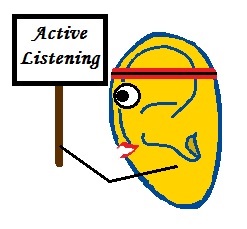 The answer may surprise you. They both know the importance of listening. Relationships are easy when everything is going well, but just like for a company, the real test is when there is a problem.
The answer may surprise you. They both know the importance of listening. Relationships are easy when everything is going well, but just like for a company, the real test is when there is a problem.
Dealing with these problems is more than just getting the issue resolved. Did you ever get the customer service representative who was listening to the voices in his head and not you? Sure the problem may have been resolved but his listening skills were terrible. A person who is upset needs to feel that the other person is listening to what he is saying and how he is feeling. Below are three steps that you can use to ensure that you are actively listening.
- Note the feelings as well as the facts
The key to solving any problem is to get to the heart of the issue, how the person feels. If you do not acknowledge the feelings, nothing that you do to fix the problem will ever be satisfactory. Fixing the problem is just half of the equation. The other half is letting the person express how she feels. If you are at work and someone has a problem, ask if you can take notes. If she says yes, get a piece of paper and draw two columns. As you listen, jot down the key facts in one column and the feelings that the person expresses in the other. If she says no or you are in a situation where this is not feasible, just do so mentally.
- Ask probing questions
Get as much information as possible. Ask relevant and timely questions. Do not interrupt the person or cut him off but ask questions to get the answers you need in order to fix the problem. As you are listening, use non-verbal clues such as nodding your head, and at the end confirm what he has said and acknowledge his feelings.
- Use appropriate body language, and non-verbal cues
Conversations and interactions take place in just about every form and through just about every medium. Regardless of the medium, what you say is judged less then how you say it.
If you are face-to-face or on a video call, your body language is critical. In this case, use receptive/relaxed facial expressions, open body posture, leaning forward and eye contact aka R.O.L.E. (To learn more about R.O.L.E. read our post ROLE.) In addition, try not to put a desk in between you and the other person. You should also nod at appropriate times to show that you are paying attention.
If your conversation is taking place by phone, insert brief words such as “yes” and “I understand.” This will show that you are still on the line and actively listening.
Email, social media and text are probably the easiest methods for the person with the problem or complaint but the hardest for the person who needs to come up with the resolution. When someone is upset and emailing, texting, or posting the problem, you are already at a disadvantage. You cannot show that you are actively listening, and your tone may be misinterpreted by the person reading your response. Your written response must contain empathy and acknowledge the facts and feelings involved. Take time to review your response before sending. Put yourself in the other person’s position as they read it to see if the tone is what you intended.
These steps involve practice before they can become second nature, but the payoff can be great. While this is designed for customer service, these same principles can be used in our everyday lives, with friends, family and co-workers. To learn more about listening, take the Customer Service course at MyCourseRoom.com and join us on our club forum board, ‘How well do you listen?’ Simply log in or create your free learner account today.
Plan for success
“By failing to prepare, you are preparing to fail.” ― Benjamin Franklin
Planning is the first and the most important pieces of a project regardless of what kind of project it is. In order to plan for a project, whether it be a multi-million dollar project or putting on a school play, three key elements are needed.
- Defining the objectives and scope of the project:
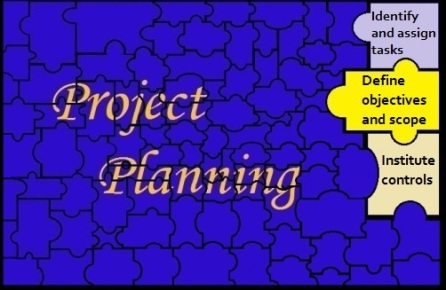 “If you don’t know where you’re going, any road will get you there.” – Lewis Carroll. Don’t let your projects go down the rabbit hole without direction. You need to know what you want your project to be and the objectives of the project.
“If you don’t know where you’re going, any road will get you there.” – Lewis Carroll. Don’t let your projects go down the rabbit hole without direction. You need to know what you want your project to be and the objectives of the project.
For example: The objective of the project is for XYZ Middle School put on a production of “Alice in Wonderland” on December 15, 2014 at 6:30pm. This play is to raise money for Toys for Tots
- Identifying and assigning the tasks that are required to complete the objective: Using the above example, some of the tasks will include selecting cast members, creating sets, making costumes, selling tickets, etc.
- Instituting controls: Controls are used to verify how things are going and if the project is on schedule. Setting milestones, project reviews and a clear communication plan are some of the project controls.
By following these three key elements of project planning, you help ensure success. With a solid plan in place, those involved in the project will have a firm understanding of what the project is and what is expected. The success of any project is preparation and commitment.
To learn more about project planning, take the free course, Project Planning, at MyCourseRoom.com.
Prepare yourself for the adventure of aging
“You are never too old to set another goal or to dream a new dream. – Les Brown
We are constantly being told to buy products that claim to slow down the aging process, and we know that millions of dollars are spent each year on cosmetic surgery solely for the purpose of looking younger. These are all superficial. The art of staying young is in the mind. Aging is inevitable; aging gracefully is a choice.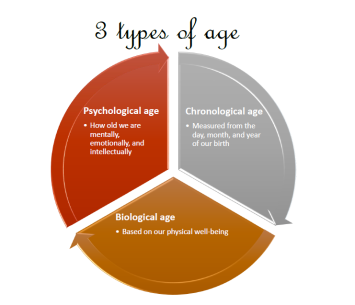
Aging can be defined in three ways:
- Our conventional/chronological age is measured from the day, month, and year of our birth…our ‘birthday.’
- Our biological age is based on our physical well-being. The more stress placed on our body due to our lifestyle and the environment in which we live greatly impacts how old our body feels. The more physical, mental and emotional stress we have, the faster our body ages.
- Our psychological age is how old we are mentally, emotionally, and intellectually – in other words, our maturity level and the sharpness of our mind.
The following are some tips on how to remain “young”:
- Stay positive
A positive outlook can do wonders. We all interpret new experiences and try to make sense of what impact these experiences are going to have on us. If we only see things in a negative way, the impact is going to affect our mental and physical well-being. If you tend to only see the negative, it is time to clean your ‘mental filter.’ Look for the positive in each experience.
- Stay mentally active
Research has recorded that people truly committed to new and fulfilling experiences – whether they are social, intellectual, emotional, physical, or spiritual – live longer, healthier lives.
- Stay healthy through wise food choices
“You are what you eat” is a common phrase with very true implications. Food is a key factor in aging. The foods that we eat have a lasting impression on our bodies, long after we have finished a meal. Eat foods that are healthy for you. This does not mean that you cannot grab a quick bite at a fast-food place, but just make sure that it is not an everyday thing. Incorporate foods into your diet with beneficial antioxidants, vitamins, and minerals:
Selenium – tuna, broccoli, garlic
Zinc – whole grains, seafood
Folic acid – new research has strongly emphasized the importance of folic acid (found in green, leafy vegetables) in reducing the risk of cancer
Beta carotene – carrots, zucchini
Vitamin C – green leafy vegetables, kiwi, berries
To learn more about aging and aging gracefully, take the Aging Gracefully course at MyCourseRoom.com and join us on our club forum board, ‘How do you stay young?.’ Simply log in or create your free learner account today.
Growing Global Demand for Certification
Global demand for certified employees across industries is growing. Many companies now require specific certifications regardless of the education level and experience of potential employees. It has become a primary vehicle for screening applicants as it provides employers with measurable evidence that the applicant has the required knowledge base for the position.
certifications regardless of the education level and experience of potential employees. It has become a primary vehicle for screening applicants as it provides employers with measurable evidence that the applicant has the required knowledge base for the position.
Take an example of being treated by a medical doctor. Who would you choose? A board certified doctor or one who has a medical degree but is not board certified? What about an elementary teacher for your child? Would you prefer a teacher with an undergraduate degree and a teacher certification or just someone with an undergraduate degree? Proof of certification provides employers and customers with a sense of comfort as it is an indicator that the service provider has up-to-date knowledge of best practices required for the job.
The level of education for a professional is also becoming a primary differentiator as an indicator of merit. There was a time when a high school diploma was sufficient for entry-level positions. Now, the expectation has changed. An undergraduate degree is often required for entry-level positions, and a master’s degree is preferred for jobs that will evolve into supervisory roles. A specific certification along with the level of education provides a common denominator for recruiters to assess specific career skills as well as reduce the significant number of resumes received for advertised jobs.
The global IT market, as an example, has become tremendously competitive; there are many qualified people competing for the same jobs. A certification may not ensure that the person will perform well, but it gets him or her into the position at which point the company relies on appraisals to review performance and determine possible promotions. Many companies include in their annual budget an amount per employee for training to receive desired certifications as well as continued training to maintain their certifications. For example, to receive a Project Management Professional (PMP) certification, an individual must meet the education and experience requirements and also be trained for 35 hours on project management principles as outlined by the PMI Institute. This training can only be received from a registered education provider approved by the PMI Institute to issue Professional Development Units (PDU). Furthermore, to maintain the certification, the professional is required to submit 60 hours of specific development or training from a registered education provider every three years.
Finally, other benefits of certification include continued enhancement of knowledge base including global best practices, credibility, and recognition among colleagues, clients, and management.
At www.mycourseroom.com, we provide global workers access to high quality, interactive, expert knowledge in the areas of project management, leadership, ethics, compliance, human resource management, and just-in-time knowledge based on current trends in specific sectors.
Brain Development
The human brain is a complex organ capable of learning and adapting throughout our lives. 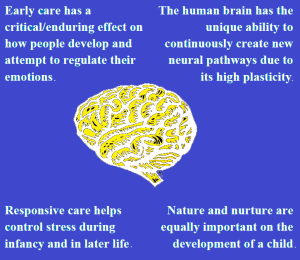 Scientists have made amazing discoveries about the development of the human brain, and today we know that babies are born ready to learn. In fact, these early years are the most active period of brain development in a person’s life and form the foundation of who that child becomes. Every sight, sound, touch, taste, and smell that the baby experiences has a direct effect on the way the baby’s brain develops. Relationships in the future are greatly impacted by what happens during these formative years. Therefore, every person involved in a child’s early life plays an important role in shaping the development of the child’s brain.
Scientists have made amazing discoveries about the development of the human brain, and today we know that babies are born ready to learn. In fact, these early years are the most active period of brain development in a person’s life and form the foundation of who that child becomes. Every sight, sound, touch, taste, and smell that the baby experiences has a direct effect on the way the baby’s brain develops. Relationships in the future are greatly impacted by what happens during these formative years. Therefore, every person involved in a child’s early life plays an important role in shaping the development of the child’s brain.
MyCourseRoom offers an important course for everyone who works with children. Abuse Prevention, SIDS Awareness, and Brain Development is an 8 clock hour course and is FREE to everyone who registers at www.MyCourseRoom.com.
Below are four interesting pieces of information about a child’s brain development.
- Nature and nurture are equal.
While genetics play an important role in the development of the human brain, a child’s early years are equally as important. A child’s brain is only about 25% developed when born. Education and enrichment are essential from the very beginning.
- Early care and nurturing have a critical and enduring effect on how people develop and attempt to regulate their emotions.
Infant brain development is much more than simply providing sensory experiences for a child. Brain development occurs within the moment-to-moment interactions with the people who care for the child. Children will pattern their actions and emotional responses after what they have received. Reacting to a child with warm, nurturing and loving methods will help teach a child to regulate and control their emotions. In addition, the more that a bond between a child and a caregiver is nurtured, the better the child will do. Attachments between a child and caregiver will actually help the child’s brain to develop and will aid in the learning process. These strong attachments will help the child feel more secure and as they age will help give them more self-confidence.
- Responsive care helps control stress during infancy and in later life.
Warm, responsive care has not only been shown to comfort a baby but also to have a protective function and to help organize the brain. It helps to ‘immunize’ the baby against the effects of stress, both during infancy and later in life. Children who have received responsive care tend to have lower levels of stress hormones. They are better able to calm themselves more quickly than children who lacked such responsive care. Because they are able to calm themselves more effectively when stressed, they are less likely to lash out.
- The human brain has the unique ability to continuously create new neural pathways due to its high plasticity.
The ability for a human to learn does not stop at a certain age. We learn from the moment we are born to the moment we die. While we learn and build neural pathways throughout life, the early years of a child’s life is a critical time. Neurons can create connections to other neurons with more ease and effectiveness. This is the reason why a baby or young child can learn multiple languages and recognize voices and faces with relative ease, but learning a language as an adult is more complicated.
To learn more about brain development, take the FREE Abuse Prevention, SIDS Awareness, and Brain Development course from MyCourseRoom.com.
